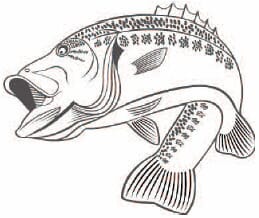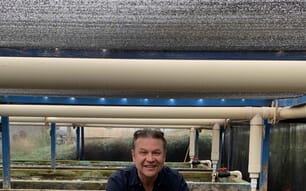
Tiny plants and animals, called plankton, are necessary for successful fish production. Water insects and other organisms use the plankton for food. Bluegill (“bream”) and redear sunfish (“shellcrackers”) feed on the insects, and bass feed on the small sunfish. As plankton production is increased, fish production also increases.
You can apply fertilizer to stimulate plankton and increase fish production in any size pond. A fertilized pond can produce three to four times as many pounds of fish each year as an unfertilized pond. A well-fertilized, well-managed pond usually produces 200 to 400 pounds of fish per acre each year.
Does Your Pond Need Fertilizer?
Most ponds do not need to be fertilized. Here are some cases where this is true:
-
Ponds not fished heavily. Fertilizing a large pond is a waste of time and money if you fish it only occasionally, and fertilizing may lead to serious problems with overpopulation and stunting. Most pond owners with unfertilized ponds don’t keep fish at the recommended harvest rates and run the risk of stockpiling fish, which can lead to stunting. Fertilization can increase necessary harvest rates three to four times, and this level of harvest can only be achieved with heavy fishing.
-
Muddy ponds. Mud keeps sunlight from passing through the water. Plankton must have sunlight to grow. If a pond stays muddy most of the time, do not fertilize the pond until the mud problem is corrected. Also, clay particles that cause muddy water actually bind up phosphorus and make it unavailable for plankton.
-
Ponds infested with undesirable fish. Fertilizing a pond with socalled “trash fish” results in three to four times as many of these fish. If undesirable fish dominate the pond, poison the pond, restock, and then begin fertilizing. Request Extension Publication 1954 for details on renovating farm ponds.
-
Ponds infested with weeds. During warm months, pond weeds use up the fertilizer intended for microscopic plants. The pond stays clear even after repeated fertilizer applications, but your weed problem gets worse.
-
Unbalanced fish population. If the bream population is overcrowded, it means there are not enough bass to keep the bream under control. Fertilizing under these conditions results in many more stunted bream. Request Extension Publication 1952 and Information Sheet 1479 for information on how to determine balance and to correct problem populations.
-
Ponds fed commercial feeds. It is not necessary to fertilize ponds if you follow a feeding program. Feeding serves the same purpose as fertilization but acts at a higher level of the food chain. Feeding increases fish production but can reduce water quality similar to fertilization.
-
Excessive water flow. In some spring-fed or creek-fed ponds, the volume of water flowing through the pond is too high to maintain adequate plankton blooms. In this case, fertilizer is constantly being diluted or flushed from the system and will have little positive effect.
-
Ponds with alkalinity less than 20 ppm. Alkalinity, which is the measure of dissolved negative ions in the water, buffers pH and promotes fertility. Ponds with low alkalinity do not respond to fertilization. Adding crushed agricultural limestone can correct this problem.
-
Ponds used as a primary water source. Fertilizing ponds creates green water that can taste or smell bad.
-
Ponds designed for wildlife. Wildlife (such as ducks) prefer ponds that are shallow, clear, and have some vegetation. Fertilization causes the water to turn green, shading out submerged plants, or causes aquatic plants to become thick and choke the system, making it undesirable for many wildlife species.
-
Ponds with a history of low oxygen. Ponds that have a history of oxygen problems or fish kills should not be fertilized. Fertilization increases productivity, which increases oxygen use. This may increase chances of having oxygen- related fish kills.
Importance of Liming
Do not start a pond fertilization program without first finding out the lime requirement of the soil on the pond bottom. Applying phosphate fertilizers to ponds with acid soils is a waste of money and time.
The type of soil in your pond also determines how much fertilizer you should apply. Collect a bottom mud sample from several places around the edge of the pond, mix it together, let it dry, and send it to the Extension Soil Testing Laboratory, Box 9610, Mississippi State, MS 39762 for a lime requirement test. Your county Extension agent has boxes for collecting and shipping the soil samples.
Ponds in some areas of Mississippi may need as much as 3 tons of agricultural or dolomitic limestone per surface acre to bring the soil pH up to the point that phosphorous fertilizers can promote adequate growth of microscopic plants and animals.
Apply lime fairly evenly to the pond surface using a platform barge with water sprayer. Tie two jon boats together and place a large sheet of half inch plywood over the bow to make a platform barge, and use a trash pump to spray pond water across lime piled on the the platform. If this is not feasible, try to spread lime in shallow water in the upper end of the pond or on land, as close to the water’s edge as possible, that drains directly into the pond.
In new ponds, you can disk lime into the soil before filling the pond. Apply the lime at least two to three months before starting fertilization, and repeat every three to four years.
Type and Rate of Fertilizer To Use
Several methods and types of fertilization programs can be used, and all can be effective if the pond soil pH and water chemistry are in appropriate ranges. Pond fertilizers are available in liquid, granular, or powdered forms. Liquid fertilizers dissolve most readily, followed by powders, and then granular types.
Typical formulations for liquid fertilizers include 10-34-0 and 13-37-0. The key ingredient is phosphorous (middle number), and any similar formulation is adequate. Apply these fertilizers at the rate of ½ to 1 gallon per surface acre, depending on pond location and soil fertility.
Powdered, highly water-soluble fertilizers, such as 12-49-6 or 10-52-0, are also available and are effective and convenient to use. Typically you apply these formulations at the rate of 4 to 8 pounds per surface acre.
Granular fertilizers are more traditional and are available in numerous formulations. Most fertilizer such as Triple Super Phosphate (0-46-0), which is the most economical formulation.
Ponds located in areas of rich soils (such as the Delta, black belt, and Jackson prairie) should respond well to 4 pounds of 0-46-0 per surface acre. Those located in the red clay soils of north and central Mississippi coastal plain soils do best with 8 to 12 pounds of 0-46-0 per surface acre. In some areas, it may be difficult to buy 0-46-0, but 0-20-0 is usually available. If this is the case, use twice the amount recommended for 0-46-0. A relatively new granular technology provides a timed release of the fertilizer. This formulation is a 10-50-0 granular pellet you can apply in the early spring, and it slowly releases fertilizer throughout the season.
How and When To Apply Fertilizer
Begin fertilization in the spring when water temperatures have stabilized at 60 degrees Fahrenheit or higher. As a rule of thumb, this means about March 15 in south Mississippi and April 1 in central and north Mississippi.
If you use liquid, powder, or traditional granular formations, make the first three applications of fertilizer two weeks apart, then make another application whenever you can see your hand clearly with your arm under water at elbow depth. If you cannot make a check this way because of discoloration of the water from minerals, fertilize the pond at 3- to 4-week intervals from spring through September.
If you use the timed-released fertilizer, apply 25 pounds of pellets per acre. This is a one-time application and provides gradual release of nutrients until fall. This one-time application eliminates the six to twelve periodic applications necessary with traditional fertilizers.
Never broadcast granular fertilizer, and never apply undiluted liquid fertilizer. In either case, the fertilizer will rapidly sink to the bottom and be tied up in soils rather than becoming available in the water. You can broadcast powdered formulations, since they are highly water soluble and do not sink to become tied up in bottom muds.
If you use granular forms or the timed-release pellet, apply them in a way that minimizes fertilizer- soil contact. You can do this by constructing fertilizer platforms — one for each 5 to 6 acres of water. Build the platform so it can be raised or lowered. Lay the required number of sacks of fertilizer on the platforms so 4 inches of water will cover them. Tear off the top layer of each sack. Wave action will distribute the fertilizer throughout each pond.
Platform construction can be difficult in existing ponds. An alternative method is simply to place fertilizer bags in shallow water with the tops cut out. The bags serve to separate soil and fertilizer, and wave action dissolve and distribute the fertilizer.
Dilute liquid fertilizer with at least two parts water to one part fertilizer before application. In small ponds, you can effectively spray liquids from the bank with hand-held sprayers. Boats make application easy in larger ponds. You can spray the diluted fertilizer over the water surface or let it flow into the prop-wash of an outboard motor. You can pour powdered formulations directly on the water surface.
Maintaining a Fertilization Program
Once you begin a fertilization program, you must continue it consistently year after year. This is because fertilization raises the productivity of the pond up to four times the natural productivity, meaning that there are four times more fish (by weight) than the pond would support if you didn’t apply fertilizer. So stopping fertilization would reduce pond productivity and then starve the fish.
September 2008
